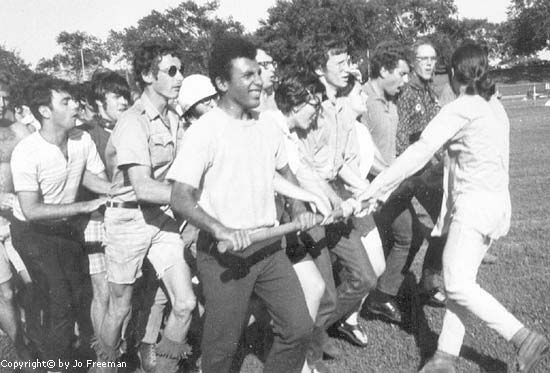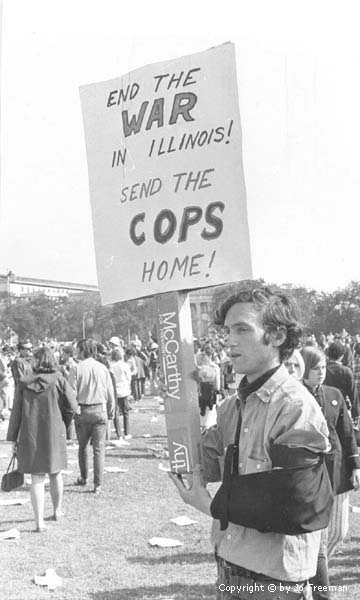From Jerry Rubin, an activist, "Don't trust anyone over thirty." A reflection from Former Cop Norm Nelson, "Let’s put it this way, we were ready for those SOBs." Words from Rubin's fellow activist, Abbie Hoffman, "A modern revolutionary group heads for the television station."
In a year of turmoil, 1968 culminated in the meeting of the police and the anti-war demonstrators at the Democratic National Convention in Chicago. Despite efforts to maintain order, prejudices overpowered the atmosphere and tensions escalated into violence. Was that violence inevitable? The deep felt bigotry in the hearts of both demonstrators and police stewed in anticipation for the week that would forever tarnish the city of Chicago's reputation. What was the point? Who would benefit? Outside the 1968 DNC in Chicago, bigotry avoided the challenge of finding common ground between the demonstrators and police; consequently the opportunity to make real progress in forming a nonviolent humanity was wasted.
Thursday, December 11, 2008
"People Must Be Free I Hope the Day Comes Soon"
Leading up to the convention, it had been a difficult year for all of America. 1968 was characterized by tragedy and confrontation. On April 4th, the Civil Rights leader Martin Luther King Jr. has been assassinated. 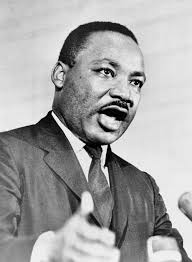
Also in April, students at Columbia University had essentially shut down their institution in protest of several University policies.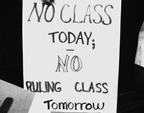
Later, on June 5th, John F. Kennedy's brother, Bobby Kennedy, had been shot and killed.
Also, "on March 31, President Johnson announced he would not seek re-election. Johnson's favorability ratings were in the mid-30% range and polls showed even less support for his Vietnam War policies (about 23%.)"
The face of the nation was constantly changing. The movements that defined the year were losing their leaders and tensions continued to climb.

Also in April, students at Columbia University had essentially shut down their institution in protest of several University policies.

Later, on June 5th, John F. Kennedy's brother, Bobby Kennedy, had been shot and killed.
Also, "on March 31, President Johnson announced he would not seek re-election. Johnson's favorability ratings were in the mid-30% range and polls showed even less support for his Vietnam War policies (about 23%.)"
The face of the nation was constantly changing. The movements that defined the year were losing their leaders and tensions continued to climb.
"Won't You Please Come to Chicago Show Your Face"
Before the convention began, two sides were already pitted against one another. On the one side, the Chicago Police. On the other, the demonstrators. Certain traits characterized one's position, and certain faces stood out among these crowds like poster children for their agendas. Principally, among the demonstrators, the Youth International Party founders, Jerry Rubin and Abbie Hoffman played a large part in the protest. As members of the YIPPIES, the name with which they referred to themselves, Hoffman defined themselves saying, "The YIP is a party—like the last word says—not a political movement." Keith Lampe, also a YIPPIE, offered, "Our attitude is basically satirical."
An article from TIME magazine on April 5th, 1968, described the behavior of the YIPPIES saying,
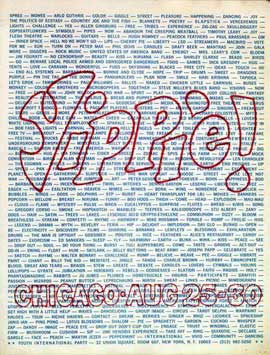
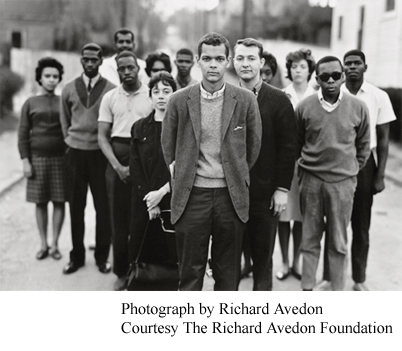 Although Hoffman, had history with the Student Nonviolent Coordinating Committee during the Civil Rights Movement, that organization's reputation of wearing collared shirts and skirts was not present in the physical appearance of the YIPPIE demonstrators. In contrast to the dignified look of the SNCC, the YIPPIES, namely Jerry Rubin and Abbie Hoffman often characterized themselves with a more radical appearance.
Although Hoffman, had history with the Student Nonviolent Coordinating Committee during the Civil Rights Movement, that organization's reputation of wearing collared shirts and skirts was not present in the physical appearance of the YIPPIE demonstrators. In contrast to the dignified look of the SNCC, the YIPPIES, namely Jerry Rubin and Abbie Hoffman often characterized themselves with a more radical appearance. 

In an article from TIME magazine on December 6th, 1968, it was reported that,
Not only did the demonstrators distinguish themselves with counter culture garb, they also made sure to proceed their presence in Chicago with a host of threats.
In the same article from TIME magazine on December 6th, 1968, explained how these threats were perceived saying,
However it is also clear that radicals like Jerry Rubin and Abbie Hoffman are quite aware of the way in which they are perceived. In this quote from Hoffman, his understanding is made particularly clear,
Above is a discussion between activist Jerry Rubin and host Phil Donahue.
An article from TIME magazine on April 5th, 1968, described the behavior of the YIPPIES saying,

"They poured into the vast main concourse of Manhattan's Grand Central Station 3,000 strong, wearing their customary capes, gowns, feathers and beads. They tossed hot cross buns and firecrackers, and floated balloons up toward the celestial blue ceiling. They hummed the cosmic "Ommm," snake-danced to the tune of Have a Marijuana, and proudly unfurled a huge banner emblazoned with a lazy "Y", and continued saying, "A dozen youths scaled the information booth, ripped off the clock hands, scribbled graffiti and defiantly passed around lighted marijuana "joints" in full view of the Tactical Patrol Force."
 Although Hoffman, had history with the Student Nonviolent Coordinating Committee during the Civil Rights Movement, that organization's reputation of wearing collared shirts and skirts was not present in the physical appearance of the YIPPIE demonstrators. In contrast to the dignified look of the SNCC, the YIPPIES, namely Jerry Rubin and Abbie Hoffman often characterized themselves with a more radical appearance.
Although Hoffman, had history with the Student Nonviolent Coordinating Committee during the Civil Rights Movement, that organization's reputation of wearing collared shirts and skirts was not present in the physical appearance of the YIPPIE demonstrators. In contrast to the dignified look of the SNCC, the YIPPIES, namely Jerry Rubin and Abbie Hoffman often characterized themselves with a more radical appearance. 

"Yippie Guru Abbie Hoffman, 32, cadged dinner from his four police tails, yipped up a storm in Lincoln Park (where he passed out phone numbers of cops and city officials for telephonic harassment), and was ultimately arrested for wearing a four-letter word on his forehead."Former cop Mel Latanzio describes,
“There was no distinguishing hippies, Yippies, Diggies, SDSers, and all of those radical groups. They went under different names, but we kept our eyes on all of them. I think they were pretending that they were different at times, but that was just a ploy, because when they got on the street, they all behaved the same way. Your regular patrolman was not going to be able to tell these people apart, and they didn’t seem to care what we thought, anyway; even if they weren’t trouble, they wanted to look the part.”
In an article from TIME magazine on December 6th, 1968, it was reported that,
"Police are not normally apt to be shocked by four-letter words. But, as in the Columbia University uprising last spring, they were outraged to see obscenities printed on placards or hear them shouted by apparently well-educated, middle-class young men and women. The barrage of epithets helped convince some policemen that their opponents were scarcely human—and they all too often shed their own humanity. Witnesses frequently noted that if a demonstrator being chased by police got away, the cops would simply club whoever else was handy."The YIPPIES aimed to celebrate their counter culture by holding "a six-day 'Festival of Life' in comic contrast to what they call the Democratic Party's 'National Death Convention'." Their satirical comedy continued when the YIPPIES attempted to nominate their own presidential candidate. Using a play on words, the YIPPIES presented their candidate, "Lyndon Pigasus Pig", in reference to the term "Pig" used to describe any cop. This stunt resulted in the arrest of Jerry Rubin along with six other demonstrators.

Not only did the demonstrators distinguish themselves with counter culture garb, they also made sure to proceed their presence in Chicago with a host of threats.
In the same article from TIME magazine on December 6th, 1968, explained how these threats were perceived saying,
"Mayor Richard Daley and his police and military aides appeared to accept at face value all of the fiery statements made by the demonstration leaders. Chicago's newspapers repeatedly listed diabolical threats aimed at the city, ranging from burning Chicago down by flooding the sewers with gasoline, to dumping LSD in the water supply, to having 10,000 nude bodies float on Lake Michigan."Although those threats were never realized, among the demonstrators were some lightly armed activists, according to TIME magazine,
"many were equipped with motorcycle crash helmets, gas masks (purchasable at $4.98 in North Side army-navy surplus stores), bail money and anti-Mace unguents. A handful of hard-liners in the "violence bag" also carried golf balls studded with spikes, javelins made of snow-fence slats, aerosol cans full of caustic oven-cleaning fluids, ice picks, bricks, bottles, and clay tiles sharpened to points that would have satisfied a Cro-Magnon bear hunter."

However it is also clear that radicals like Jerry Rubin and Abbie Hoffman are quite aware of the way in which they are perceived. In this quote from Hoffman, his understanding is made particularly clear,
“We are working on a huge Youth Festival in Chicago at the time of the Democratic Convention. I hope to get to participate. I’m currently on trial for supposedly hitting a cop with a bottle in a demonstration. I can’t imagine what they are talking about, me being a flower child and all that.”
Above is a discussion between activist Jerry Rubin and host Phil Donahue.
Mayor Richard Daley's public sentiment before the start of the convention was, 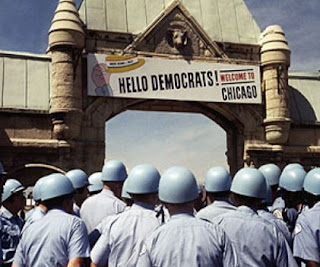
Whether the sentiment from this public statement made by Mayor Daley was to be upheld throughout the convention had yet to be seen. From the book Battleground Chicago by Frank Kusch, the force of the Chicago police is outlined,

Above is a clip of the tension between Mayor Daley and the Democratic party inside the Convention Center.
"It is only fitting that during this dynamic democratic process, there is present in our city a cross-section of representation of the voices of America—liberal, moderate, conservative, and radical, young and old, hawk and dove, hippy and square … and this is the way it should be because this is America."

Whether the sentiment from this public statement made by Mayor Daley was to be upheld throughout the convention had yet to be seen. From the book Battleground Chicago by Frank Kusch, the force of the Chicago police is outlined,
"The usual police contingent of 6,000 officers on the streets grew to 11,900 on twelve-hour shifts, up from the usual eight. The city requested the mobilization of 5,649 Illinois National Guardsmen, with an additional 5,000 on alert, bolstered by up to 1,000 Federal Bureau of Investigation (FBI) officers and military intelligence officers. Waiting for signs of trouble in the suburbs would be 6,000 army troops, including members of the elite 101st Airborne Division. The men were to be equipped with bazookas and flamethrowers."


Above is a clip of the tension between Mayor Daley and the Democratic party inside the Convention Center.
Former Officer Warren MacAulay remembers,
Cop Ray Mihalicz speaks to the growing tension saying,
Yet, not all cops were outspokenly awaiting the confrontation. Officer Grant Brown explained,

Mayor Daley stood by his commitments proclaiming, "Law and order will be maintained", he also stated his case against the demonstrators, whom he referred to as "terrorists", explaining that they "use the foulest of language that you wouldn't hear in a brothel house."
To further illuminate his righteousness and ward off attacks upon his "Gestapo" tactics, Mayor Daley distributed "We Love You Daley" signs inside the convention center.
Neither side appeared to maintain an open mind. The demonstrators became as outrageous as possible. Smoking pot in front of cops, nominating a pig for president and one printed a certain four letter word across his forehead; these weren't exactly the characteristics of peace makers. In opting to wear only the clothes that defined their counter culture movement, making a mockery of the system with whom they would soon be in contact and sending absurd threats towards the city, they closed down nearly all opportunities for communication.
The cops also joined in the hostilities. They were surrounded by increased levels of police power. With flamethrowers and bazookas in their position, their mission was clear. Mayor Daley had them convinced that they needed to maintain order and let no one take over their city. The threats they heard were internalized, no matter how absurd, and the mixture of fear and animosity towards the demonstrators created a dangerous mentality. There would be little time or consideration for discussion.
“I know people who wore a uniform who really didn’t care—they hated the entire generation and they used any excuse they could find to go after them and teach them a lesson. These Yipps with their tough talk were making that very easy for some of the members."
Cop Ray Mihalicz speaks to the growing tension saying,
“I remember the years before—the radicals used to wear black all over or turtlenecks when it was hot enough to fry an egg on the hood of your car and sunglasses on cloudy days. By the time the war heated up, mid-decade, I suppose, the bad ones and the normal kids—if you can call them normal—all looked the same. It was like they wore this uniform that said, ‘I don’t belong in this society, look out for me.’ They might as well put a bull’s eye on their back.”
Yet, not all cops were outspokenly awaiting the confrontation. Officer Grant Brown explained,

“The problem for all of us was that we didn’t know what or where the hit was going to come from. We worried about the delegates, we worried about the infrastructure, the power, the water, and worried about them putting acid in the water—we didn’t know what was going to happen, and there was fear, all right, as silly as some of that fear may seem now.”
Mayor Daley stood by his commitments proclaiming, "Law and order will be maintained", he also stated his case against the demonstrators, whom he referred to as "terrorists", explaining that they "use the foulest of language that you wouldn't hear in a brothel house."
To further illuminate his righteousness and ward off attacks upon his "Gestapo" tactics, Mayor Daley distributed "We Love You Daley" signs inside the convention center.

Neither side appeared to maintain an open mind. The demonstrators became as outrageous as possible. Smoking pot in front of cops, nominating a pig for president and one printed a certain four letter word across his forehead; these weren't exactly the characteristics of peace makers. In opting to wear only the clothes that defined their counter culture movement, making a mockery of the system with whom they would soon be in contact and sending absurd threats towards the city, they closed down nearly all opportunities for communication.
The cops also joined in the hostilities. They were surrounded by increased levels of police power. With flamethrowers and bazookas in their position, their mission was clear. Mayor Daley had them convinced that they needed to maintain order and let no one take over their city. The threats they heard were internalized, no matter how absurd, and the mixture of fear and animosity towards the demonstrators created a dangerous mentality. There would be little time or consideration for discussion.
"So Your Brother's Bound and Gagged"
“The two questions I was always asked were: (1) is there any chance that the police won’t create a bloodbath? (2) Are you sure that Tom and Rennie don’t want one?”This quote from activist David Dellinger in reference to the preconceptions of both the demonstrators (Tom and Rennie) and the Chicago Police lays down the key issue. Neither side was ready to prevent violent confrontation. Neither side aimed to maintain nonviolent order. Neither side sought to find common ground to make progress with the other.
From the TIME magazine article, "Dementia in the Second City" published on Friday September 6th, 1968, the meeting between demonstrators was described,
"The demonstrators constantly taunted the police and in some cases deliberately disobeyed reasonable orders. Most of the provocations were verbal—screams of 'Pig!' and fouler epithets. Many cops seemed unruffled by the insults. Policeman John Gruber joked: 'We kind of like the word pig. Some of us answer our officers 'Oink, oink, sir,' just to show it doesn't bother us.' The police reacted more angrily when the demonstrators sang God Bless America or recited 'I pledge allegiance to the flag.'
The assault from the left was furious, fluky and bizarre. Yet the Chicago police department responded in a way that could only be characterized as sanctioned mayhem. With billy clubs, tear gas and Mace, the blue-shirted, blue-helmeted cops violated the civil rights of countless innocent citizens and contravened every accepted code of professional police discipline
In some of the wilder fighting, the demonstrators hurled bricks, bottles and nail-studded golf balls at the police lines.
But on Wednesday night…Outraged when the protesters lowered a U.S. flag during a rally in Grant Park beside Lake Michigan, the cops hurled tear gas into the crowd.
'The force used was the force that was necessary,' insisted Police Superintendent James Conlisk Jr. He could point to the fortunate fact that no one was killed. He also pointed out—almost with pride—that the casualties included 152 cops."
And again, excerpts from the TIME magazine article "Who Were the Protestors?" from Friday September 6th, 1968, the events are further explained,
"Long before the Democratic Convention assembled, the protest leaders who organized last week's marches and melees realized that they stood no chance of influencing the political outcome or reforming "the system." Thus their strategy became one of calculated provocation.
The aim was to irritate the police and the party bosses so intensely that their reactions would look like those of mindless brutes and skull-busters."
"In a Land That's Known as Freedom How Can Such a Thing Be Fair?"
In 1968 two issues of TIME magazine covered the reactions of concerned citizens regarding the events during the convention. These are the sentiments they had to share:
Sir: I am young and concerned. I attended the rally at Grant Park in Chicago and witnessed demonstrations. When alongside people my age, my mind told me all their actions were right. I remember myself "yeahing" when my country's flag was torn down and I remember calling the law I've always respected "pigs." Now I ask: How could I?
My generation is one of concern, hope, courage, strength and vigor; also one of neglect, dejection, fear, weakness and impotence. Shall our enemy thrive by taking advantage of our youthful characteristics? I wonder. I wonder who really put the $10 and $20 bills in the hat at the rally in support of the demonstration. I wonder who printed all the propaganda I received those days. I wonder who paid for the transportation of those I met from New York, Philadelphia, Washington, D.C., and Los Angeles. I wonder who supported the ex-G.I.s from Viet Nam who infiltrated my mind with horror and hate. Yes, I wonder.
ROSE SWIDERSKI
Blue Island, Ill.
Sir: When individuals arrive in a city with bail money, anti-irritants and take riot training, then subsequently are struck in a police confrontation, there does not appear to be much cause for lamentation. All thinking people deplore overreaction to provocation that results in injury to bystanders, but historically, general assent to the rule of the mob has been followed by harsh repression when some semblance of order must be reinstituted.
Many of the crocodile tears being shed are a manifestation of the losers' syndrome that would brand Agnew as a racist and Humphrey as a rightist, both of which are blatant nonsense.
JOHN F. BERRIGAN III
Manhattan
Sir: The demonstrators went too far. While being represented at the convention by men seeking change through the system, they went outside the system and took to pressure tactics. And change outside the system is revolution plain and simple. Fellow students, don't you believe in representative government? As long as you are a minority, you must submit to the majority and try harder.
DUNCAN A. BUELL
Covington, La.
Sir: I am appalled and angered by the behavior of my fellow students and other young people involved in the riots. Legitimate protest for legitimate cause is something that I believe in, but when thousands of otherwise levelheaded men and women risk beatings in an effort to defame the Chicago police department, which is all that was accomplished, they make a mockery of anything the protest movement has ever stood for. The hollow chant "the whole world is watching" seems to acquire a double meaning.
PATRICK MCMANUS
Chicago
http://www.time.com/time/magazine/article/0,9171,838653,00.html
Sir: As a young historian born during World War II, I had never really been able to form a mental picture of the way the Nazi storm troopers came to power in Hitler's Germany. After watching the scenes of the brutal attacks by the Chicago police on the peace demonstrators, I think I know what that tyranny must have been like. Mayor Daley's inhuman repression was a blot on the fabric of human dignity. Daley for anti-Man of the Year.
HUGH B. HAMMETT
Charlottesville, Va.
Sir: My husband and I were among the onlookers who were tear-gassed on Michigan Avenue. We thought it a minor discomfort to endure while the police attempted to control that frenzied, filthy, foul-mouthed mob of cretins. We watched these "innocents," as you called them, doing their "thing," i.e., overturning police motorcycles, setting fires on the sidewalks, rocking a van containing policemen in an attempt to overturn it, foisting signs in our faces reading "F— the draft," waving the Cong flag as they chanted "Ho-Ho-Ho Chi Minh." Spare me the bleeding heart's account of how they were brutalized. They were a danger to every one of us in Chicago and, unless stopped as they were here, constitute an even greater danger to our nation tomorrow.
MRS. RICHARD J. WATERBURY
Glen Ellyn, Ill.
Sir: As a Chicagoan, I am ashamed of the brutality perpetrated by Mayor Daley and the zoo he calls "the finest police force in the world." Having spent three nights on Michigan Avenue observing the occupation of "Prague West," I find absurd Daley's charge that news coverage of the conflict was one-sided. King Richard was fortunate that the TV cameras could not see everything. One night, a cop overtook a young girl fleeing from tear gas. Grabbing her by the hair, he hit her across the face with his nightstick, ripped off her blouse, ripped off her bra. After clubbing her over the head a few more times, the cop left her—half-naked, bleeding and unconscious in the street—as he ran on into the melee. He was smiling. Daley earlier said that "no mob will control the streets of Chicago." But what do you do when the police are the mob?
Perhaps I'm just overreacting. I had legitimate reason to be on South Michigan Avenue during convention week: I live there. One unidentified policeman didn't think this sufficient and hit me across the back of the neck with his billy club. Dazed by the blow and overcome by tear gas, I could not get up from the sidewalk. Finally, a young Negro reached out his hand, saying, "Let me help you, brother. Now you, too, know what police brutality is."
ROBERT A. BASSI Chicago
"We can change the World. Rearrange the World."
From the threats that proceeded the demonstrator's presence to the orders given by Mayor Daley, confrontations were already decided before the convention even began. Each side anticipated the other with fear and disdain. Neither side entered the event intending to understand the other. Neither side ascended on the streets of Chicago hoping to find common ground. Both expected trouble.
When we allow our egos to close our eyes to those with whom we interact, how do we intend to make progress? When we misunderstand each other as unable to relate and communicate, when then do we expect to work together? And if we don't expect to work together, in a world that needs change, how can we continue to live together?
In the book Be Here Now by Baba Ram Dass, the action of protesting is discussed. In the following excerpt, he teaches a lesson that gets at the heart of the 1968 Democratic National Convention in Chicago.
 The 1968 Convention is now a chapter in our nation's history. We cannot change what occurred, but we can learn from it. If we look beyond clothes and uniforms, beyond age and skin color, beyond age and agenda, we can see that we are all living in the same world. No matter how much we disagree, if we want to better understand each other, at the very least we need to be able to communicate. To communicate we must step beyond the idea of the "other", beyond the dichotomy of "us" versus "them". The demonstrators and police during the convention in Chicago epitomized "us" versus "them". The result was violent. Yet the opportunity to "realize that behind the ways in which you differ, you are the same" still exists. Once we put aside the insulting signs, the weapons and the bigotry, the communication can begin.
The 1968 Convention is now a chapter in our nation's history. We cannot change what occurred, but we can learn from it. If we look beyond clothes and uniforms, beyond age and skin color, beyond age and agenda, we can see that we are all living in the same world. No matter how much we disagree, if we want to better understand each other, at the very least we need to be able to communicate. To communicate we must step beyond the idea of the "other", beyond the dichotomy of "us" versus "them". The demonstrators and police during the convention in Chicago epitomized "us" versus "them". The result was violent. Yet the opportunity to "realize that behind the ways in which you differ, you are the same" still exists. Once we put aside the insulting signs, the weapons and the bigotry, the communication can begin.
When we allow our egos to close our eyes to those with whom we interact, how do we intend to make progress? When we misunderstand each other as unable to relate and communicate, when then do we expect to work together? And if we don't expect to work together, in a world that needs change, how can we continue to live together?
In the book Be Here Now by Baba Ram Dass, the action of protesting is discussed. In the following excerpt, he teaches a lesson that gets at the heart of the 1968 Democratic National Convention in Chicago.
“Let us consider an example of the relation of a group called ‘hippies’ and a group called ‘police.’ If a ‘confrontation’ occurs during a protest, what is the result?...If the hippies see the police only as ‘them’ and the police see the hippies only as ‘them’…then the result is an increase in polarization and distance between the two groups. Each returns to its headquarters and plans an increase in its own strength to overcome ‘them.’
Why does the distance increase? Because nobody wants to be ‘them.’ Everyone wants to be ‘us.’ And if you meet someone who sees you as ‘him’ or ‘one of them,’ that meeting arouses in you all your paranoia and you, in turn, see the other person as ‘him’ or ‘one of them.’
Such cycles get worse and worse until there is violent confrontation. What is the conscious alternative? It is not to avoid protest or confrontation. Rather it is for the participants to become more ‘conscious.’ And what does that mean? It means that though you may be protesting against someone or some group, you realize that behind the ways in which you differ, you are the same. That is, you understand protest as a form of social communication among US…and that ‘where it counts’ there is only US. US includes black and white, young and old, man and woman, American and Russian, rich and poor, saint and rogue.
So the simple rule of conscious participation is:
YOU MAY PROTEST IF YOU CAN LOVE THE PERSON YOU ARE PROTESTING AGAINST AS MUCH AS YOU LOVE YOURSELF.
You may disagree with all his values, but behind them all…HERE WE ARE…all manifestations of the Spirit.
The effect of ‘conscious’ protest is that it reduces the polarization and the paranoia and thus allows each side to hear the other’s concern more clearly because there is less fear and anxiety. It’s all so simple(and so difficult). There can be conscious revolution.”
 The 1968 Convention is now a chapter in our nation's history. We cannot change what occurred, but we can learn from it. If we look beyond clothes and uniforms, beyond age and skin color, beyond age and agenda, we can see that we are all living in the same world. No matter how much we disagree, if we want to better understand each other, at the very least we need to be able to communicate. To communicate we must step beyond the idea of the "other", beyond the dichotomy of "us" versus "them". The demonstrators and police during the convention in Chicago epitomized "us" versus "them". The result was violent. Yet the opportunity to "realize that behind the ways in which you differ, you are the same" still exists. Once we put aside the insulting signs, the weapons and the bigotry, the communication can begin.
The 1968 Convention is now a chapter in our nation's history. We cannot change what occurred, but we can learn from it. If we look beyond clothes and uniforms, beyond age and skin color, beyond age and agenda, we can see that we are all living in the same world. No matter how much we disagree, if we want to better understand each other, at the very least we need to be able to communicate. To communicate we must step beyond the idea of the "other", beyond the dichotomy of "us" versus "them". The demonstrators and police during the convention in Chicago epitomized "us" versus "them". The result was violent. Yet the opportunity to "realize that behind the ways in which you differ, you are the same" still exists. Once we put aside the insulting signs, the weapons and the bigotry, the communication can begin.
Works Cited
Works Cited
"Abbie Hoffman Quotes." BrainyQuote.com. 2008. Dec. 2008 <"http://www.brainyquote.com/quotes/authors/a/abbie_hoffman.html">.
"Another Mayor Daley lands another convention. Oops." BlueGal. 14 Mar. 2008. Dec. 2008 <http://bluegal.wordpress.com/2008/03/18/another-mayor-daley-lands-another-convention-oops>.
"Brief History Of Chicago's 1968 Democratic Convention." All Politics CNN TIME. 1997. Dec. 2008 <http://www.cnn.com/allpolitics/1996/conventions/chicago/facts/chicago68/index.shtml>.
"Bullet Films." Yamagata International Documentary Film Festival. 2003. Dec. 2008 <http://www.yidff.jp/2003/cat081/03c089-e.html>.
Campbell, Rick. "40 Years After: The Whole World is Watching-Chicago 1968, Part 4." Chron.com. 30 Aug. 2008. Dec. 2008 <http://blogs.chron.com/40yearsafter/2008/08/the_whole_world_was_watching_c_4.html>.
"Daily News: News Photos." Chicago 1968 DNC. 20 Aug. 2008. Dec. 2008 <http://www.nydailynews.com/news/politics/galleries/chicago_1968_dnc/chicago_1968_dnc.html>.
Dass, Ram. Be Here Now. New York: Three Rivers P, 1971. 59.
DemocraticMediaMKII. "1968 DNC: Democratic nightmare in Chicago." YouTube.com. 29 Sept. 2008. Dec. 2008 <http://www.youtube.com/watch?v=epxmx_58too>.
Et Cetera: Publick and Privat Curiosities. 26 Sept. 2007. Dec. 2008 <http://disembedded.wordpress.com/2007/09/26/the-1968-democratic-national-convention-and-the-chicago-seven-trial>.
Dwendt66. "Yippies for Nixon." YouTube.com. 07 Oct. 2007. Dec. 2008 <http://www.youtube.com/watch?v=ogeonr275aa>.
Freeman, Jo. "Confrontation at the 1968 Democratic Convention in Chicago." Jo Freeman.com. Dec. 2008 <http://www.jofreeman.com/photos/convention68.html>.
Goodman, Bonnie K. "Chicago 1968... 40th Anniversary." YouTube.com. 08 Sept. 2008. Dec. 2008 <http://www.youtube.com/watch?v=eabwgszhzja>.
"Graham Nash Chicago Lyrics." MusicSongLyrics.com. Dec. 2008 <http://www.musicsonglyrics.com/g/grahamnashlyrics/grahamnashchicagolyrics.htm>.
Howardeppis. "Tortoise - Gamera - Chicago '68 (the whole world isn't watching)." YouTube.com. 17 Sept. 2008. Dec. 2008 <http://www.youtube.com/watch?v=2e5dslu_vve>.
HP-TIME. "A Week of Grievances." TIME.com. 06 Sept. 1968. Dec. 2008 <http://www.time.com/time/magazine/article/0,9171,900333,00.html>.
HP-TIME. "After Chicago." TIME.com. 13 Sept. 1968. Dec. 2008 <http://www.time.com/time/magazine/article/0,9171,838653,00.html>.
HP-TIME. "Chicago Examined: Anatomy of a 'Police Riot'" TIME.com. 06 Dec. 1968. Dec. 2008 <http://www.time.com/time/magazine/article/0,9171,844633,00.html>.
HP-TIME. "Dementia in the Second City." TIME.com. 06 Sept. 1968. Dec. 2008 <http://www.time.com/time/magazine/article/0,9171,900317,00.html>.
HP-TIME. "Refighting Chicago." TIME.com. 27 Sept. 1968. Dec. 2008 <http://www.time.com/time/magazine/article/0,9171,902314,00.html>.
HP-TIME. "The Politics of YIP." 05 Apr. 1968. Dec. 2008 <http://www.time.com/time/magazine/article/0,9171,900067,00.html>.
HP-TIME. "The Shock of Chicago." TIME.com. 20 Sept. 1968. Dec. 2008 <http://www.time.com/time/magazine/article/0,9171,838726-1,00.html>.
HP-TIME. "Who Were the Protestors?" TIME.com. 06 Sept. 1968. Dec. 2008 <http://www.time.com/time/magazine/article/0,9171,900318,00.html>.
"Image:Yippie poster.jpg." Wikipedia.com. 1 Mar. 2007. Dec. 2008 <http://en.wikipedia.org/wiki/image:yippie_poster.jpg>.
"Independent Lens: Chicago 10." PBS.org. 02 Oct. 2008. Dec. 2008 <http://www.pbs.org/independentlens/chicago10/chicago10.html>.
"Jerry Rubin Quotes." Thinkexist.com. 1999-2006. Dec. 2008 <http://thinkexist.com/quotes/jerry_rubin>.
Kusch, Frank. "An excerpt from Battleground Chicago: The Police and the 1968 Democratic National Convention." The University of Chicago Press. Dec. 2008 <http://www.press.uchicago.edu/misc/chicago/465036.html>.
Madman in the Marketplace. "Sedition." LiberalStreetFighter.com. 18 Sept. 2008. Dec. 2008 <http://www.liberalstreetfighter.com/ee/index.php?/weblog/comments/sedition>.
"Martin Luther King Jr. Images." Google.com. 2008. Dec. 2008 <http://images.google.com/images?client=safari&rls=en-us&q=martin%20luther%20king%20jr.&ie=utf-8&oe=utf-8&um=1&sa=n&tab=wi>.
Pownall, Ron. "Photos: The '68 Democratic Convention." TheBostonPhoenix.com. 27 Aug. 2008. Dec. 2008 <http://thephoenix.com/boston/arts/67129-photos-the-68-democratic-convention/?rel=inf>.
Pugmire, Tim. "The Chicago convention -- a loss amid chaos." Minnesota Public Radio. 20 Nov. 2006. Dec. 2008 <http://minnesota.publicradio.org/display/web/2006/11/20/mccarthy3b>.
"Remember 1968 in Chicago?" ChicagoTribune.com. 1968. Dec. 2008 <http://www.chicagotribune.com/news/chi-071231protests1968-photogallery,0,4881008.photogallery>.
Subscribe to:
Posts (Atom)




